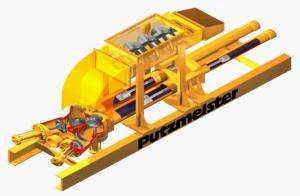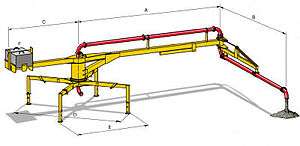Concrete pump

A concrete pump is a machine used for transferring liquid concrete by pumping. There are two types of concrete pumps.
The first type of concrete pump is attached to a truck or longer units are on semi-trailers. It is known as a boom concrete pump because it uses a remote-controlled articulating robotic arm (called a boom) to place concrete accurately. Boom pumps are used on most of the larger construction projects as they are capable of pumping at very high volumes and because of the labour saving nature of the placing boom. They are a revolutionary alternative to truck-mounted concrete pumps.
The second main type of concrete pump is either mounted on a truck or placed on a trailer, and it is commonly referred to as a line pump or trailer-mounted concrete pump. This pump requires steel or flexible concrete placing hoses to be manually attached to the outlet of the machine. Those hoses are linked together and lead to wherever the concrete needs to be placed. Line pumps normally pump concrete at lower volumes than boom pumps and are used for smaller volume concrete placing applications such as swimming pools, sidewalks, and single family home concrete slabs and most ground slabs.
There are also skid mounted and rail mounted concrete pumps, but these are uncommon and only used on specialized jobsites such as mines and tunnels.
History
Until the early 20th century, concrete was mixed on the job site and transported from the cement mixer to the formwork, either in wheelbarrows or in buckets lifted by cranes. This required a lot of time and labor. In 1927, the German engineers Max Giese and Fritz Hull came upon the idea of pumping concrete through pipes. They pumped concrete to a height of 38 meters (125 ft) and a distance of 120 meters (130 yd). Shortly after, a concrete pump was patented in Holland in 1932 by Jacob Cornelius Kweimn (Jacobus Cornelius Kooijman). This patent incorporated the developer's previous German patent.[1]
Mechanism
Concrete pump designers face many challenges because concrete is heavy, viscous, abrasive, contains pieces of hard rock, and solidifies if not kept moving.

Usually, piston pumps are used, because they can produce hundreds of atmospheres of pressure. Such piston-style pumps can push cylinders of heterogenous concrete mixes (aggregate + cement).
The pump below uses a transfer tube valve, and the one on the right uses seat valves.
Example of pump performance
To illustrate, below are data on a typical concrete sample pump BRF 42.14 H:

- Vertical reach of boom: 41.9 meters (137 ft).
- Horizontal reach of boom: 38.0 meters (124.7 ft)
- Pumping rate: 140 cubic meters per hour (180 cuyd/h).
- Concrete pressure: 70 bar (7,000 kPa; 1,015 psi).
- Cylinder length: 2,100 mm (82.677 in).
- Cylinder diameter: 210 mm (8.268 in).
- Number of substitutions of strokes per minute: 27.
- Number of outriggers legs: 4.
Gallery
-
Construction site with concrete pump
-
A Putzmeister concrete pump in Germany in 1985
-
Concrete pump folded for transport
-

Boom concrete pump
-
.jpg)
Concrete pump
-

Putzmeister brand positive displacement mortar and plaster pump
-

Photo showing a concrete pump working a large foundation pour, showing deployed outriggers, rebar mats, and concrete mixer delivering concrete.
-
.jpg)
Fully deployed concrete pump, showing outriggers and boom in use while receiving concrete.
See also
- High-density solids pump - concrete pump technology in general
- Concrete mixing transport truck
References
- ↑ Illingworth J.R. (1972). Movement and Distribution of Concrete. McGraw-Hill. p. 132. ISBN 978-0070942363. Retrieved 2012-06-18.